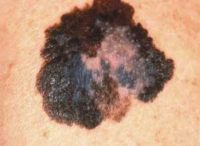05 Jun What Surveillance Testing Should Be Done After Melanoma Diagnosis?
MedicalResearch.com Interview with:

This image depicts the gross appearance of a cutaneous pigmented lesion, which had been diagnosed as superficial spreading malignant melanoma (SSMM). Note the roughened edges of this mole, and its heterogeneous, mottled, multicolored appearance, which are all characteristics that should evoke suspicions about its classification.
CDC Image
Dr. Diwakar Davar, MD
Assistant Professor of Medicine
Division of Hematology/Oncology
University of Pittsburgh
MedicalResearch.com: What is the background for this study? What are the main findings?
Response: The optimal surveillance strategy to detect recurrence in cutaneous melanoma remains elusive. Risk of recurrence increases with higher stage, and is especially high for patients with stage IIIC disease. Although consensus guidelines agree on surveillance imaging for high-risk (stage IIB-IIIC) MEL, there is no consensus regarding optimal frequency/modality in these patients. NCCN guidelines suggest chest radiography (CXR) at 6- to 12-month intervals for stage IA-IIA melanoma patients; although this is controversial. There exists a great deal of practice variation in the surveillance of these patients.
MedicalResearch.com: What should readers take away from your report?
Response: The incidence of pulmonary and extra-pulmonary metastases increases with stage. CXR reliably detects pulmonary metastases in patients with stage I-III melanoma.
Addition of LDH did not increase detection rate of either pulmonary or extra-pulmonary metastases. Concordant with the published data, most extra-extra-pulmonary metastases were diagnosed on advanced imaging done to evaluate examination findings and/or patient symptoms.
Our data suggests that CXR reliably detects pulmonary metastases in stage I-III melanoma, while LDH was relatively insensitive in detecting pulmonary or extra-pulmonary metastases. CXR provides useful information on pulmonary recurrence. The incidence of extra-pulmonary metastases in stage II-III melanoma argues for additional approaches to surveillance.
MedicalResearch.com: What recommendations do you have for future research as a result of this work?
Response: CXR is a cost-effective and reliable method of detecting pulmonary metastases. LDH does not appear to add significantly to the accuracy of CXR in detecting metastases. Larger studies would be useful to validate these findings.
Disclosures: Merck, Checkmate Pharmaceuticals, BMS – clinical trial support
Citations: upcoming ASCO 2018 abstract:
Surveillance for melanoma : Results of a database study of stage I-III Melanoma
[wysija_form id=”3″]
The information on MedicalResearch.com is provided for educational purposes only, and is in no way intended to diagnose, cure, or treat any medical or other condition. Always seek the advice of your physician or other qualified health and ask your doctor any questions you may have regarding a medical condition. In addition to all other limitations and disclaimers in this agreement, service provider and its third party providers disclaim any liability or loss in connection with the content provided on this website.
Last Updated on June 5, 2018 by Marie Benz MD FAAD
